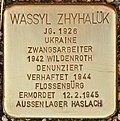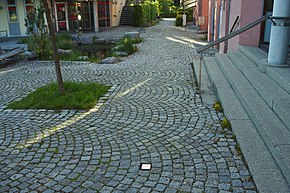List of stumbling blocks in the Fürstenfeldbruck district
The list of stumbling blocks in the Fürstenfeldbruck district contains an overview of the stumbling blocks in the Fürstenfeldbruck district in Bavaria . Stumbling blocks are supposed to remind of the fate of the people who were murdered, deported, expelled or driven to suicide by the National Socialists. The stumbling blocks were laid by Gunter Demnig. As a rule, they are relocated before the victim's last freely chosen place of residence.
Fürstenfeldbruck district
A stumbling block was laid in each of three communities in the Fürstenfeldbruck district .
Grafrath
| Stumbling block | inscription | Location | Name, life |
|---|---|---|---|

|
WASSYL ZHYHALÜK
JG. 1926 UKRAINE FORCED LABOR 1942 WILD ROTH denounced ARRESTED 1944 FLOSSENBÜRG MURDERED 02/12/1945 EXTERNAL STORAGE HASLACH |
Grafrath , Hauptstraße 64 (in front of the entrance to the municipal administration) |
Wassyl Zhyhalük was born in Ukraine in 1926. He had at least one brother or sister. Most recently the family lived near Jaslowez. Zhyhalük came to Grafrath in 1926 as a forced laborer. He was employed as a farm worker on a farm. After allegedly insulting a villager, he was deported to the Flossenbürg concentration camp in December 1944 . From there he was transferred to the Sportplatz satellite camp on December 8, 1944 . Wassyl Zhyhalük was buried on February 12, 1945 in a subcamp of the Natzweiler-Struthof concentration camp with 222 other victims in a mass grave. His mother died shortly after the end of the war, and his father hoped until his death at the age of 90 that his son would still come home. In 1946 his body was transferred to an honorary grave, and in 1953 he was reburied in another honorary grave. |
Groebenzell
| Stumbling block | inscription | Location | Name, life |
|---|---|---|---|

|
KURT SCHROETER JG LIVED HERE . 1882 DEPORTED 1943 AUSCHWITZ MURDERED 02/02/1944 |
Groebenzell , Bahnhofstrasse 3 |
Kurt Schroeter was born as Kurt Schlesinger on March 5, 1882in Berlin . His parents were Albert Bernhard Schlesinger and Valerie, née Solmsen. He had a younger brother, Erich. The family owned a mother-of-pearl factory in Berlin-Charlottenburg. From the age of eleven he received private tuition, which also included violin lessons and a study of music. From 1900 he studiedmechanical and engineering scienceat the Technical University of Berlin, specializing in electrical engineering. In 1907 he successfully completed his studies. He then worked for the Association of German Electrical Engineers, after playing a concert with a pianist friend without notes, he decided to become a musician. He was trainedas a concert masterby Carl Flesch . In 1912 Schlesinger married Ilse Marie Johanna Charlotte von Voigts-Rhetz. Instead, he gave up his Jewish faith, and his wife's family, in turn, did not agree to the marriage "under stand". The couple had two daughters: Marianne (born 1913) and Sigrid (born 1920). In June 1920, Kurt Schlesinger was adopted by Berta Schroeter and took her name on. In 1919 he had started violin training at the Stern Conservatory of Music with Siegfried Eberhardt, in September 1920 he taught for two years at this conservatory, and in 1926 he completed his training. In 1923 the family moved to Groebenzell, to a villa they had bought there. Schroeter became a freelance violin teacher in Groebenzell and the surrounding area, he taught in the Marquartstein Landschulheim, in Augsburg and in Munich . He made an international reputation for himself and in 1924 published “Flesch / Eberhardt. Inappropriate or natural violin technique ”. In 1931 the monthly magazine “Die Musik” printed Kurt Schroeter's article “The art of violin as the archetype of the art of living”. On February 10, 1936, Schroeter was expelled from the Reich Music Chamber, so he could no longer teach and the family's livelihood was taken away. The journal “Der Nervenarzt” published his “The Indisposition and its Treatment” in July 1936. As a result, Schroeter emigrated to the Netherlands in orderto gain a foothold againin Amsterdam as a concertmaster and violin teacher. There he lived first hidden with a friend, later semi-legally at different addresses. His wife filed for divorce in 1941 in order to save the property from the Nazis. From September 1942 to January 1943 Schroeter wrote a diary for his children, in which he wrote of the helpfulness of Dutch friends, but also of the increased attacks on Jews. On August 16, 1943, Kurt Schroeter was arrested in a raid on the street and taken to the "Jewish Theater" collection point. There he had tospenda few weeks until he was deported to the Vught-Hertogenbosch concentration camp . He was registered in the concentration camp on September 9, 1943 with the prisoner number 7174. On November 15, 1943 he was deported to the Auschwitz concentration camp and registered there with the prisoner number 163397. At the end of 1943 he was transferred to quarantine camp B II, where "old age" was diagnosed. Kurt Schroeter lost his life in the night of January 2, 1944. On that day, 141 prisoners from the men's camp were selected for the gas chambers, Kurt Schroeter was among them.
His divorced wife received encrypted information from a friend who believed he had been arrested for illicit medical activities. On December 20, 1943, she wrote to the Reich Commissioner for the Occupied Dutch Territories asking for a pardon, but by then her husband was already in the Auschwitz extermination camp. His daughter Marianne became a translator, emigrated to Sweden in 1936 and returned to Berlin in 1952. She died in 1974. His daughter Sigrid emigrated to Switzerland in 1935, where she died in 199. Ilse Schroeter died in 1968. The relocation of the Stolperstein was originally rejected by the Gröbenzell council. |
Schöngeising
| Stumbling block | inscription | Location | Name, life |
|---|---|---|---|

|
JOHANNA OPPENHEIMER JG WORKED HERE . 1872 FORCEDLY RELOCATED 1942 MUNICH COLLECTIVE CAMP MILBERTSHOFEN DEPORTED 1942 THERESIENSTADT DEAD 23.12.1942 |
Schöngeising , Amperstrasse 22 |
Johanna Oppenheimerwas born on July 17, 1872 in Frankfurt am Main . She came from an upper-class family that had lived in Würzburg since 1875. Her parents were the privateer Adolf Oppenheimer (1832-1904) and his wife Recha, née Hamburger, (1844-1921). She had a sister, Klara (1869–1943), who attended the teachers' college and later studied medicine. In 1875 the family moved to Munich. In 1900 Oppenheimer moved to Munich, attended the painting school of the female artists' association and became a student of Heinrich Knirr . She oriented herself towards the French Impressionists, caught up with the Schwabing bohème and ultimately succeeded as a freelance artist. From 1919 she lived in Schöngeising - with her friend, the singer and lute player Else Hoffmann. First in Orlando-di-Lasso-Strasse. Then she had a villa built for herself, the Hoffmann Villa, and set up a studio there. After the death of their mutual friend Heinrich Scherrer , they moved into his villa. After the National Socialists came to power in 1933, Oppenheimer was no longer allowed to practice her profession. From 1941 she did not leave the house - for fear of assault. In 1942 she was forced to leave. On March 29, 1942 she was deported to the Milbertshofen assembly camp and from there to the Theresienstadt concentration camp on June 17, 1942 . Johanna Oppenheimer fell ill with dysentery and died on Christmas day.
A street in Schöngeising was named after her. |
Laying data
The Stolpersteine in the Fürstenfeldbruck district were laid by Gunter Demnig on the following days:
- March 22, 2012: Groebenzell
- September 10, 2013: Schöngeising
- May 27, 2015: Grafrath
See also
literature
- Kurt Schroeter, Kurt Lehnstaedt: Days That Are So Tormenting , Notes by a Jewish Citizen from Groebenzell in occupied Amsterdam, September 1942-January 1943, R. Kovar 1993
Web links
- Gunter Demnig: Stolpersteine - website of the project
Individual evidence
- ^ Süddeutsche Zeitung : The third stumbling block in the district , accessed on June 14, 2016
- ^ Lahrer Zeitung: Descendants visit Place of Torment , accessed on June 14, 2020
- ↑ The addresses were as follows: Tesselschadestr. 6hs, old town (from July 21, 1938); Jan Luykenstr. 8bhs, old town (from December 19, 1938); van de Veldestr. 5hs (from November 21, 1940); Harmoniehof 59 bhs (from January 20, 1941) and Nieuwe Amstellaan 36 I (from January 1942).
- ↑ Kreisbote: Late memory of Holocaust victims from Gröbenzell - Stumbling block for Kurt Schroeter , accessed on June 14, 2020
- ^ Commemorative book victims of the persecution of Jews under the Nazi tyranny in Germany 1933–1945: Schroeter, Kurt , accessed on June 14, 2020
- ↑ Kurt Schroeter
- ↑ Katja Happe (Hrsg): The persecution and murder of the European Jews by National Socialist Germany Volume 12: Western and Northern Europe June 1942 - 1945, ISBN 9783486718430 , De Gruyter, Berlin 2015, pp. 294–295
- ↑ Stumbling blocks for Munich: Gröbenzell municipal council rejects Stolperstein , accessed on June 14, 2020
- ^ Süddeutsche Zeitung: Schöngeising pays tribute to concentration camp victims , accessed on June 14, 2020
- ↑ Merkur.de: Stolperstein for Johanna Oppenheimer , accessed on June 14, 2020



